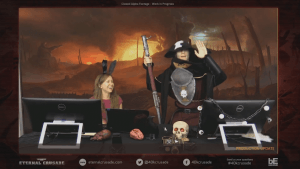Camelot Unchained BSC Days Wrap-Up

Technology: Stepping Up On Standards
3/5 on the Bat Shit Crazy Meter
If you care about the technical side of things – performance, modification, coding, testing, etc. – the best has been saved for last. Multiple tech announcements were scattered throughout the four day stream, from a powerful NVIDIA partnership to open-source UI modding and more.
Monday’s early announcement on stream involved the introduction of the full partnership formed between City State Entertainment and NVIDIA. While we’ve known about both company’s relationship for a while, it’s been revealed that NVIDIA will give assistance to help Camelot Unchained implement the PhysX engine along with GameWorks. Naturally, gamers want the best game possible, and NVIDIA wants to see PC games thrive (after all, their business relies on it.) This full-throttle support will mean that the final product will support an impressive graphics performance. And if you’re not an NVIDIA user, don’t worry: CSE promises the game won’t be exclusionary.
But if you think this new partnership is only about graphics and performance, think again. During the physics presentation on Day 4, CSE gave a clear demonstration about why this matters so much for all players. Because PhysX will be run both on the client side and the server side, running character actions simultaneously on both computers, cheaters won’t be able to prosper. Client-side server hacks to boost speed, run through walls or other characters, fly, or other similar hacks won’t be allowed by the server. So while the hacker may appear to be running under ground or blowing through a wall of giant flesh, on the server, all players will simply see them moving or running around in their proper logical positions – running into a line of players they thought they’ve busted through. This demonstration ended with a call out from Andrew Meggs to other developers to “Fix Your Shit,” a pretty epic throw down when you consider how even modern MMOs are still plagued by hackers (we’re looking at you, WildStar).
As for Camelot Unchained’s User Interface (UI), programmers and modders can start flexing their fingers now. The entire UI will be built using Chromium, and will be available as open-source code via GitHub (it’s already there!). It’s written in TypeScript, uses jQuery, and includes the underscore.js library. The team hints that anyone that can create a webpage can create a UI mod, and that’s a promising standpoint for the community as a whole.
Additionally, in-game chat will be available through multiple methods. Using XMPP technology, chat will be accessible through any compatible program, including the web. This means that you won’t have to log into the game to connect with your friends, guild mates, or realm. However, CSE notes that inter-realm chat will not be supported now or in the foreseeable future, so don’t plan on using the feature to spy for, or harass, another realm.
One last neat thing on the technical side of Camelot Unchained is its continuous patching system. What this means is that the entire development team, from coders to artists, can make changes on the live servers. Rather than taking a slow implementation method and waiting for a patch to add changes, CSE can implement anything when it’s ready to go live, from an improved graphical effect to a balancing mechanic. This will then be patched in to all players on the server, ensuring quick and instantaneous change. CSE is also opening up its Hatchling and Wyrmling servers to its testers. While Wyrmling is a more stable and standard environment, Hatchling is the internal development server, allowing players to jump in and see development at work. It’s a pretty brave venture, and we hope that they will continue to use similar server strategies for testing after the game goes live, too.
Articles You May Enjoy
- GrandChase Review (Android)
- I have to admit I was pleasantly surprised when I picked up GrandChase for the purpose of writing this review.
- Shape a dynamic open world when Fractured Online's Early Access launches
- Fractured Online, a dynamic open world MMORPG from Dynamight Studios and Gamigo, is ready to make its biggest announcement yet!
- Path of Exile Ascendancy Expansion Preview
- Path of Exile reaches into their ever growing book of backstory to this time pull a tale that began roughly 200 years ago.













